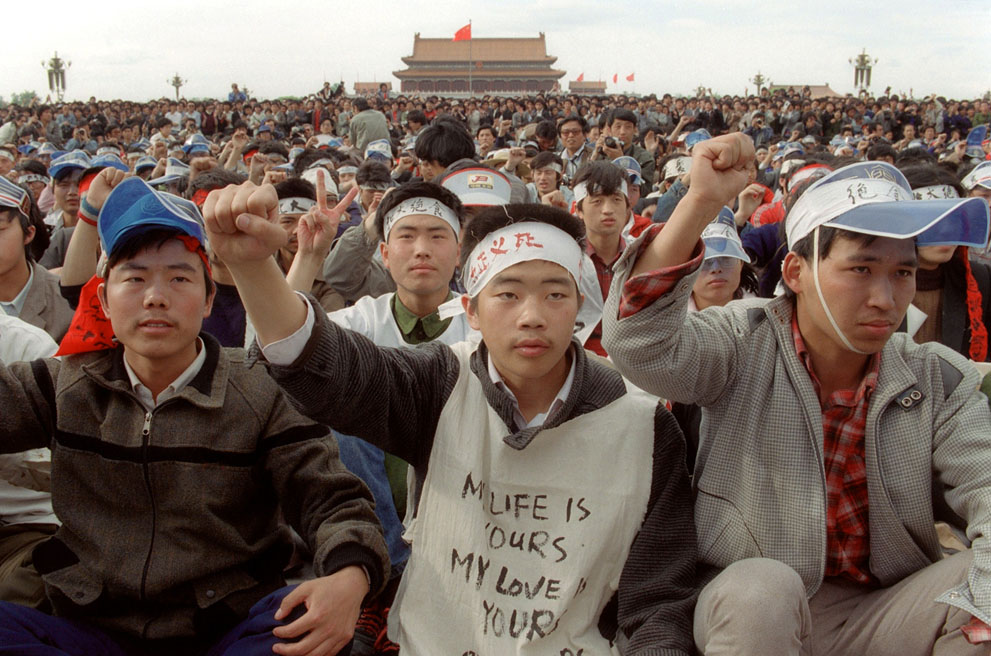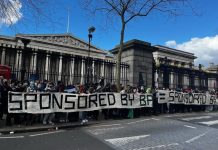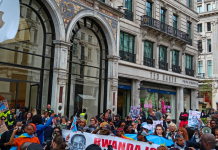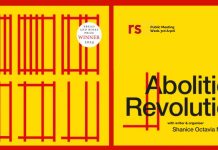4 June marks the 25th anniversary of the Tiananmen Square massacre. Charlie Hore looks back at the inspirational movement that went before, and repression that followed.

Twenty-five years ago, a mass protest movement exploded across China’s cities, posing potentially the biggest challenge to China’s rulers since 1949. The Tiananmen Square movement, as it came to be known is now best remembered for the horrific massacre that ended it. On 4 June 1989 troop columns and tanks smashed their way into the heart of Beijing, killing hundreds if not several thousands of protesters. And thousands more died or disappeared in the repression that followed.
It is right to remember them, and mark the day, to remind China’s rulers of their crime. But it is equally important to remember what they were fighting for, and the inspiration of the movement at its height.
China in 1989 was very different to China today. The economic reforms pioneered by Deng Xiaoping in the late 1970s had led to a substantial rise in living standards, most of all in the countryside where the vast majority of China’s population still lived. These were accompanied by partial social and political reforms, which dismantled many of the petty controls over everyday life that had been the norm in the Cultural Revolution.
Those new freedoms had led some, particularly young workers and students, to demand much more, and the 1980s was punctuated by a number of student protests and demonstrations. Deng’s arrival in power had also been greeted with a short-lived ‘Democracy Wall’ movement, in which young workers who had been exiled to the countryside during the Cultural Revolution published calls for greater freedoms. Both were to be important influences in 1989.
But more important was the changing economic climate. Gains of the early 1980s were threatened by inflation and job insecurity. The return of free markets meant that, when food supplies were disrupted, prices could rise very fast. By the start of 1989 urban inflation was higher than at any time since 1949.
Over-heating in the economy, and a consequent austerity drive, also meant large numbers of factories shut or laid off workers. The economic disruption led to semi-public arguments among China’s rulers.
This was a crisis of economic policy, driven by unbalanced growth rather than slump, but it was still the worst crisis since 1949. Workers who had seen their lives improving now faced losing what they had won, and a weak and divided ruling class. The scene was set for an eruption, but no-one expected the size and scale of what happened.
How it began
The 1989 movement started with the death of leading politician Hu Yaobang, who had been one of Deng Xiaoping’s lieutenants, and was seen as responsible for many of the political reforms. While it began as a movement to honour his memory, it quickly developed into an attack on other politicians, and on official corruption in general, as well as calling for greater political and social freedoms.
It exploded far beyond the size of any previous protest. On the day of Hu’s funeral, 150,000 students and supporters occupied Tiananmen Square despite the government trying to ban them. The following weekend there were solidarity marches in at least eight cities, with serious rioting in two.
The CCP attacked the students as ‘counter-revolutionary’, which only deepened the anger. The movement’s leaders sent students into the streets and workplaces to call on workers and citizens to join them.
The response was magnificent. On Thursday 28 April some 150,000 people marched across Beijing, with workers making up half of the march. The march ended with calls for nationwide demonstrations on 4 May, the 70th anniversary of an anti-imperialist student movement that had kick-started the nationalism movement of the 1920s, out of which the CCP had been born.
4 May marked another step forward for the movement, with demonstrations in cities where nothing had previously happened, although in other cities numbers were smaller than before. More importantly, after 4 May, the initiative passed back to the government, with the movement’s leaders having no real idea of the next step.
That changed decisively with the launch of a student hunger-strike in Tiananmen Square on 13 May. It began with just 200 students, but within days there were over 1,000, with thousands more sympathisers joining the camp.
The timing was brilliant – the Russian President Gorbachev was just about to make the first visit of a Russian leader to China since the Sino-Soviet split of 1962. This was meant to be a major diplomatic coup for Deng, with the two leaders appearing together in Tiananmen Square in front of cheering crowds. The students had ruined it.
The day Gorbachev arrived, there were half a million people in the square. The following day, a million, with workers marching into the square in organised groups from workplaces. The next day, two million. In at least four other cities, students organised sympathy hunger strikes, with 30,000 people camped out in central Shanghai alone. There were protest and sympathy marches in dozens of other cities across China.
Just as the movement was reaching new heights, a pan-Muslim movement broke out in western China, which saw the biggest ever religious protests in China. The demonstrations were over the publication of an Islamophobic book, and drew together Muslims of different nationalities across at least five provinces as well as in Beijing and Shanghai.
The government reacted very quickly, banning the book and organising mass burnings of it. The two movements were separate, but the government’s swift response showed how fearful they were of any widening of out of the protests.
18 May saw one final attempt to defuse the protests, with a televised meeting between government ministers and the student leaders. The ministers patronised the students, and the students in turn humiliated them. The following day martial law was declared, troops began to move into Beijing, and the city erupted.
Martial law
The People’s Liberation Army had entered Beijing in early 1949 as liberators. 40 years on, the idea that they would repress the protests was unthinkable. Disbelief turned to rage, and workers across the city formed barricades on all the main roads, with numbers of workplaces deserted and the subway lines shut down by workers.
Within two days a British eyewitness could write:
“Saturday night was the most amazing human spectacle I have ever seen. It was unreal, the amount of people who came out onto the streets. There was everybody there: the very old, sitting families with young children; babies carried in mothers’ arms; everybody was there to stop the soldiers. They thought the crunch was coming that night and they were fully prepared to try and stop them. An old man said that there were more people on the streets than he had ever seen in his life – certainly more than in 1949.”
And the following day two other eyewitnesses wrote for Socialist Worker:
“For 48 hours now the city has been entirely in the hands of the people. Though the atmosphere is tense, there is no drunkenness, no looting and no violence…We are on the main road in the east of the city The avenue is wide. Three articulated buses span it. Behind this for over 1,000 metres there must be over 100 buses arranged in intricate patterns blocking the road…
“The barricade won’t, and isn’t meant to, stop tanks. The idea is to halt and slow up moving troops to allow people to argue with the soldiers and turn them back, as has happened so often in the last couple of days. The barricades are to stand in front of, not behind…
“All of the city centre, maybe six miles wide and six miles deep or maybe more, is now under the control of workers and students. People talk of five million people, over half the entire population, out on the streets yesterday. Most of them are workers. Everywhere open-topped trucks packed with workers and students are passing…And everyone sings the Internationale over, over and over.”
It looked like a revolution, and for many people it felt like a revolution. On the barricades, and in the square itself, women came to the fore as organisers and leaders, in stark contrast to everyday life. One eyewitness estimated the crowds were 40 percent female, adding that she had never felt so safe as a woman in her life. There was a huge sense of liberation and of comradeship, with the police and the state seemingly completely absent.
But, while there was a general sense of rebellion, there was little sense of alternative. The students’ formal demands never went beyond replacing a few ministers, reversing the ‘counter-revolutionary’ judgement made in April, and an end to corruption at the top. And while the student leadership was capable of amazing organising feats, it had a very top-down structure that made little or no attempt to organise wider democratic bodies.
The Workers’ Autonomous Unions that were organised in Beijing and a number of other cities in late May were a response to this, and an attempt to build a distinctively working-class pole of attraction inside the movement. In Beijing some ten thousand people joined, though workplace organising was hampered as many people simply weren’t going to work. In most other cities, however, they simply didn’t have the time to move beyond being small groups of activists.
In the absence of any forward perspective, and with the troops backing off, the numbers on the barricades and in the square gradually shrank. In other cities there were still huge mobilisations, but they were looking to Beijing for leadership, and none came.
The massacre and its impact
There was a half-hearted attempt to send troops into Beijing during the day on 3 June, which quickly broke down, and brought massive numbers back onto the streets. They were to be no match, however, for the full scale invasion that night.
From around 10pm on 3 June tanks, armoured cars and troop carriers burst through the barricades in western Beijing, firing at random into the crowds that came out to oppose them. They moved slowly through the city towards Tiananmen Square, arriving there in the early hours of 4 June. By daybreak there were still huge crowds on the streets protesting, and numerous burnt-out tanks and troop carriers showed the extent of the resistance.
There were credible reports of large numbers of troops simply deserting, and several reports of army units attacking other units suspected of desertion. Away from the main streets, there were numerous cases of troops getting isolated and attacked by workers. But the fight-back was unorganised, and could do no more than make the invasion a costly one for the army.
Across China sympathy demonstrations exploded in what was probably the biggest mobilisation to date. Huge crowds occupied city centres, called for general strikes, and fought the police and the army. Two nights of street fighting in the southwestern city of Chengdu led to almost 300 deaths. Over 180 towns and cities saw disturbances serious enough to report to Beijing. And in Hong Kong a million people, one in six of the population, marched in protest.
The repression that followed was vicious, with 30,000 people arrested by the end of the year, and several thousands killed, often in public executions. The repression came down hardest on workers and other city-dwellers who had fought back. But it was not absolute. The government issued a list of 21 most wanted student leaders, seven of whom were smuggled out of China. Leaders of the Beijing Autonomous Workers Union managed to go on the run for several weeks before being caught.
The economic fallout was also serious, deepening the crisis that had begun at the start of the year. Between the middle of 1989 and the middle of 1990 the Chinese economy shrank slightly, the worst result since the late 1960s.
But for China’s rulers, this was a price worth paying. What was potentially the most serious challenge to their power since 1949 had to be crushed at any cost. And 25 years later the memory still resonates. When the villagers of Wukan, in Guangdong province, took over the village in late 2011 in response to the murder of a protest movement leader, they spoke to Western journalists about 1989 and how it showed that the central government cannot be beaten.
But the memory has not driven all protest off the streets. In the last 25 years China’s economy has expanded faster than at any time in history, and so too has social protest. In the mid-1990s there were mass peasant movements across central China against local authorities imposing illegal taxes. They were, to some extent, pushing at an open door, as the central government also wanted the taxes stopped, but the sheer scale of the movement forced the general government to crack down harder than they wanted to. A few years later, there were near-insurrectionary strikes by workers in state-owned companies against being denied the benefits they were promised after the companies closed. They also won – the central government took over the debts and paid out.
Migrant workers, who flooded into exporting factories from the countryside as China’s economy boomed, have also fought back continuously against the conditions they live and work in. Their struggle are even more diffuse and disparate, but two decades of refusing to accept everything thrown at them have won some residence rights in the cities they have moved to – and the right to strike itself.
The government has been forced to allow spaces for mass unrest, and to move further and further back the limits of what is allowed. This does to some extent work as a safety-valve – because people can ‘bargain by rioting’, and win some gains in doing so, they target local officials and managers rather than the central government. But it is an inherently unstable situation for two reasons: firstly, it works because those who protest win things in doing so, but that also stimulates further protests; and secondly, there are no guarantees about particular struggles not generalising.
1989 was an awful defeat, which has in many ways shaped Chinese society and social movements ever since. The university campuses were silenced, and have stayed quiet ever since. But every year, as the anniversary gets nearer, the government steps up security around Tiananmen Square, arrests journalists and intellectuals and increases the numbers of police on the streets. They know full well that while they managed to drown the movement in blood, they didn’t win legitimacy by doing so. The economic boom of the last 25 years has widened the gap between rich and poor, and led to massive corruption at all levels of the CCP and the state, corruption which is now much more visible than it was 25 years ago. The potential for another movement of the size and scale of 1989 has not gone away, and that is what frightens them.
If 4 June 1989 showed how vicious a ruling class can be in hanging on to their power, the ‘May of the masses’ showed the potential power of China’s workers to challenge them. That is the history we should reclaim and celebrate – despite the defeat, that potential power remains



















[…] As the saying goes ‘Just because you’re paranoid, it doesn’t mean they’re not after you’. A statue of a dead ruler in a field in the middle of nowhere isn’t the most obvious challenge to one of the world’s most powerful states – but could it become a rallying point for opposition? What China’s rulers fear more than anything else is the emergence of something that can pull together all those who are dissatisfied for different reasons, as the student revolt did in 1989. […]